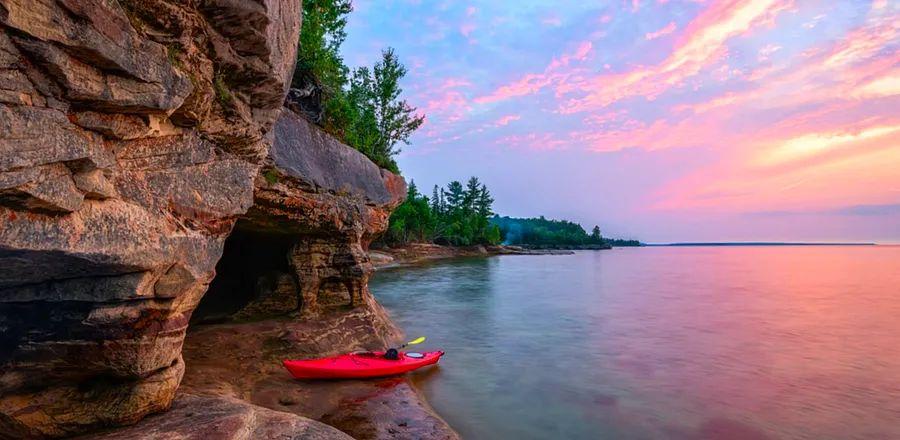Can U.S. National Parks Achieve Carbon Neutrality? The Solution Is Found in Lake Superior

Lake Superior is a realm of its own. Containing 10 percent of the world’s fresh water, it ranks among the planet's largest lakes. A journey around its perimeter would span the distance from New York City to Oklahoma City, yet the lake’s 1,300-mile route showcases lush forests, serene beaches, sea caves, and ancient lava formations. Typically, the waters are strikingly blue. This Great Lake is one of the most pristine and clear on Earth.
However, this is all at risk. Lake Superior now holds the title of the fastest-warming lake globally, according to Tom Irvine, executive director of the National Parks of Lake Superior Foundation (NPLSF). Climate change is disrupting its entire ecosystem: Severe storms, record levels of snowfall, and harmful algal blooms are becoming more frequent, while lake ice—which plays a crucial role in regulating temperature and precipitation—is becoming increasingly scarce. Additionally, there’s a human element to consider, says Irvine, a fifth-generation resident of the Lake Superior area. "Lighthouses, marinas, fisheries, and all the cultural assets around the lake are under significant threat. It is vital that action is taken."
This is where the National Parks of Lake Superior Foundation took action. In January 2023, the organization, along with various public and private entities, nonprofits, and the Band of Lake Superior Chippewa, unveiled an ambitious initiative: all five parks surrounding Lake Superior will aim to cut their carbon emissions to zero within four years. The five parks include Michigan’s Isle Royale National Park, Pictured Rocks National Lakeshore, and Keweenaw National Historical Park; Minnesota’s Grand Portage National Monument; and Wisconsin’s Apostle Islands National Lakeshore, all to be decarbonized by 2027.
Preserving the northern cold—and tranquility
Irvine notes that the ambitious initiative began with a clear objective: to phase out the diesel generators at Isle Royale National Park, a secluded island group in Lake Superior that operates completely off the grid. Currently, generators hum at Rock Harbor and Windigo— the park’s main visitor centers—and at park headquarters on Mott Island, providing power to all facilities. Staff and campers have long expressed their frustration with the reliance on fossil fuels and the constant noise during early mornings and late nights. "This is the most remote wilderness area in the continental United States," Irvine emphasizes. "[Running] diesel generators contradicts the essence of the experience."
The project’s aspirations expanded when Askov Finlayson, a Minneapolis-based outerwear brand with the slogan "Keep the North Cold," offered to finance a feasibility study aimed at achieving carbon neutrality across five parks. They inquired: What would it take to enhance the energy efficiency of all facilities in Lake Superior’s parks and create a fossil fuel-free energy system for each area? The study revealed that an investment of $10.4 million could reduce emissions by 93 percent; for $15.3 million, emissions could be completely eliminated. With funding secured through National Park Service budgeting, a full commitment was made: By going entirely carbon-free, the Lake Superior parks will reduce around 32,000 tons of carbon-equivalent emissions over the next 25 years. To put that into perspective, it’s like not burning 35,405,095 pounds of coal or not driving 79,430,578 miles in gasoline-powered vehicles.
Park personnel are beginning with tasks that most homeowners would recognize, such as upgrading to energy-efficient light bulbs, windows, insulation, and appliances. In the future, extensive solar arrays and battery energy storage systems (BESS) will provide power to off-grid setups; over 130 buildings will be retrofitted with energy-efficient heat pumps designed for cold weather; EV charging stations will be established throughout all parks; and park staff will transition completely to electric vehicles and boats, thanks to advancements in technology.
Public education is also a crucial element of this comprehensive project, according to Irvine. Visitors to the parks will encounter informational boards, ranger-led discussions, and numerous opportunities across all five park units to learn more about this ambitious initiative—and the importance of making changes in their own lives.
A model for everyone
The parks surrounding Lake Superior are not the only ones facing the impacts of climate change.
In 2010, the National Park Service launched the Climate Change Response Program (CCRP), which gave rise to the Green Parks Plan in 2012. Among its five strategic goals are achieving net-zero waste, net-zero water use, and net-zero energy for all NPS facilities and operations.
The parks around Lake Superior were the first to commit to this initiative. “Most parks have some form of [climate] initiative in progress,” Irvine notes. “We’re simply leading the charge.” Currently, 140 out of 424 parks, ranging from Antietam National Battlefield to Zion National Park, have created official Climate Action Plans. These plans encompass emissions tracking, exploring renewable energy solutions, and minimizing waste and water consumption.
Irvine states, "They now have a roadmap" for both reducing and completely eliminating emissions. He highlights a significant point: if Isle Royale, one of the most remote wilderness areas in the continental United States, can achieve 100 percent emissions reduction, then there is no justification for others not to follow suit. He emphasizes that this applies not only to the National Park Service but also to the broader American public.
“Each year, three million people visit these parks,” Irvine remarks. “Imagine if we could significantly reduce their carbon footprint as well?” Visitors to the parks, encountering strong climate initiatives, could find not just inspiration from scenic views but also the drive to take action in safeguarding their fragile planet. “All the efforts we’re undertaking in the parks can equally be applied at home,” Irvine emphasizes.
Evaluation :
5/5



